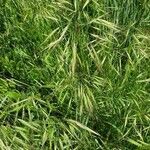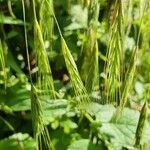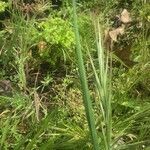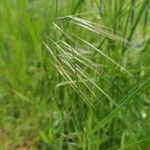Annual, caespitose. Culms 12–100 cm high. Leaves: basal sheaths densely pubescent to pilose; blade 6.5–19 cm long, 2–3.5 mm wide, puberulous to pilose. Panicles nodding, open, 3–13.5 cm long; primary branches spreading or divaricate. Spikelets erect or pendulous, cuneate, 20–34 mm long, with 5–8 bisexual florets; pedicels usually longer than spikelet, 20–75 mm long. Glumes unequal, keeled, with midnerve scaberulous and intercostal regions glabrous; lower glume 9.3–12 mm long, 1-nerved; upper glume 13.8–15.5 mm long, 3 (–5)-nerved. Callus blunt, glabrous. Lemma slightly laterally compressed, 17–21 mm long, keeled, 5-nerved, glabrous or scaberulous to scabrous; awn dorsal, arising 2–3 mm below lemma tip, 21–28 mm long, straight, entered by 3 nerves. Palea 2/3 length of lemma, glabrous. Anthers 1–1.7 mm long.
Annual 4–10 dm, the culm usually glabrous, but the sheaths and blades usually soft-hairy; blades 2–4 mm wide; ligule 1.5–2.5(–3.5) mm; infl relatively long, 1–2 dm, open, the elongate, capillary, often drooping branches mostly bearing only one or 2 spikelets, these mostly 25–31(–36) mm (to 5 cm incl. the awns), 4–8-fld, glabrous to strigose-puberulent; glumes subulate, the first 7–14 mm, 1-veined, the second 9–17 mm, 3-veined; lemmas very narrow, 13–18(–20) mm, 0.8–1.2 mm wide in side-view, 7-veined, the pair of veins nearest the midrib developed only distally, the outermost pair only proximally; awns 18–30 mm; palea almost equaling the lemma; anthers 0.9–1.6 mm; 2n=14, 28. Native of s. Europe, intr. in fields and waste places in much of the U.S., including most of our range.
Annual. Culms simple or loosely tufted, erect or geniculately ascending, 50–100 cm tall, ca. 5 mm in diam., glabrous. Leaf sheaths pubescent; leaf blades soft, 5–20 cm × 4–10 mm, pubescent; ligule 2–4 mm. Panicle lax, open, 10–20 × 7–12 cm, nodding; branches spreading, up to 10 cm, each bearing 1–3 nodding spikelets. Spikelets oblong, wedge-shaped when mature, 20–35 × 4–8 mm, florets 5–9; lower glume subulate, 8–14 mm, 1-veined, upper glume oblong-lanceolate, 10–20 mm, 3-veined; lemmas lanceolate, 15–20 × 2–4 mm in side view, 7-veined, margins white membranous, apex 2-toothed, teeth 1–2 mm, awned from sinus; awn 15–30 mm, as long as or longer than lemma body, slender, straight; palea subequal to lemma, keels sparsely ciliate. Stamens 3, anthers ca. 1 mm. Fl. May–Jun. 2n = 14.
A slender grass. It grows each year from seed. The flowering stems are 90 cm tall.




